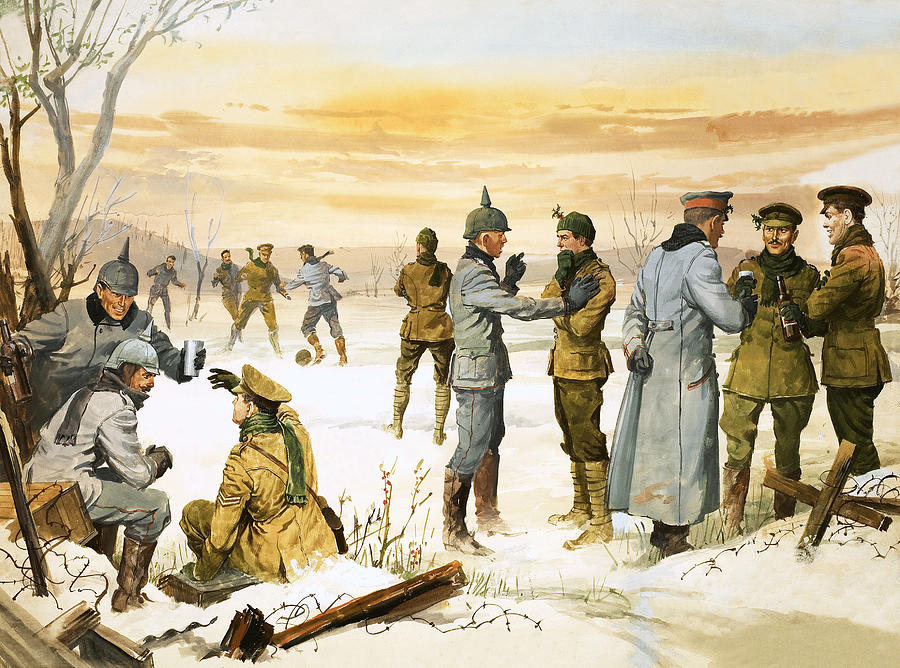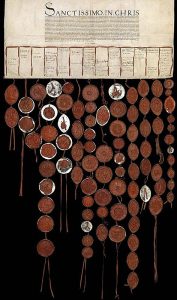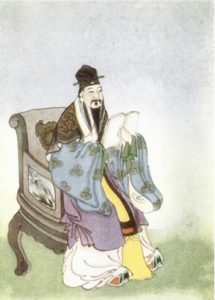The chilling cold was inescapable and constant along the trenches. This was only worsened by the rain-water flooding the muddy walls and floors. Some months had passed since the beginning of World War I, and it was now December of the year 1914. Being “home by Christmas” was out of the question, and a seemingly insuperable stalemate had been reached along the trenches stretching from the Alps to the English channel. The area between these trenches is what was known as “No Man’s Land.” This name was not a novelty in history, but it certainly increased in accuracy since its first usage. Soldiers, young men sometimes as young as fifteen, were dying by the thousands, killed by the indiscriminate fire of the machine gun, a recent addition to the arsenal of armies.1
The Allied Forces had just held off the invading German army along the Marne river, in what was called the “Miracle of the Marne.” The allied victory here signified the failure of the “Schlieffen Plan,” Germany’s attempt at sweeping a 180-degree rotation through neighboring Belgium and France. This strategy would require German troops to rapidly defeat French forces, so that they could be speedily transported via train to what would be the Eastern Front, where Russia would hopefully be slow to mobilize.2

The first trenches were dug on the western front immediately after the Battle of the Marne, which ended on September 12, 1914. The trenches were dug to survive the incoming attacks more easily. However, these trenches would later mark the border into a place of almost certain death.3 The battles of Verdun, the Somme, the Hundred Day Offensive, and Spring Offensive, fought on the Western Front, ended the lives of 5.5 million men. Sixty thousand British soldiers died on the first day of the Battle of the Somme, a death-count still unparalleled in British military history.4
The time in between battles in the trenches was miserable. The 700-kilometer system of parallel trenches was infested with rats, lice, and the bodies of dead horses and men, whom they would stop burying, because the count was so high and because they simply could not reach the bodies without a high risk of losing their own lives in the process. Crosses scattered around the trenches marked the resting places of fallen men, and also provided a grim reminder of the brutality they faced. These insane living conditions led to death by diseases such as dysentery, typhus, or cholera. This place could easily be likened to Hell on Earth. The area between trenches supported this description, a wasteland of barbed wire and tree trunks with no branches.5 Day and night, this is what the men at the front would experience. In fact, the German Expressionist Otto Dix described the trenches eloquently:
“Lice, rats, barbed wire, fleas, shells, bombs, underground caves, corpses, blood, liquor, mice, cats, artillery, filth, bullets, mortars, fire, steel: That is what war is. It is the work of the devil.”6
But then came December. A different feeling was noticeable and written about by the men in the trenches. Sniping had grown rarer, and both French and British soldiers could occasionally hear sentimental singing from the German trenches. Naturally the higher ups thought this to be some sort of tactic by the Germans. Lit up trees would appear, and shortly after, singing would ensue. The French and British soldiers were baffled, because Germans were supposed to be “barbarians.” The Christmas trees that would appear in the not so distant German trenches were somewhat of a novelty to French and British soldiers. However, they were part and parcel of the German Christmas that year.7 Some of the British soldiers shot at the Christmas trees at first, not knowing what to expect. Imagine that after shooting several times at targets near the Germans, they start calling out, promising not to shoot. After months at war, this would not make any sense to war-hardened soldiers.8
A literal calm came on the 4th of December, when an absence of gunfire was reported in some locations. The next day, a royal engineer by the name of Andrew Todd wrote to the Edinburgh Scotsman that soldiers were being “pally” with the enemy. He described their interactions, which included playful cursing at each other, and tossing newspapers from one side to the other, in places separated by only sixty yards. In a card to his mother, one rifleman wrote about how the Germans had peacefully come up and collected some of their wounded, and the British quickly went and collected their own, and after talking, both sides decided to help in burying each other’s dead. The rifleman went on to describe the enemy soldiers as “fine men.” These interactions only increased the closer they got to Christmas. By December 20, both Allied forces and Germans were intent on celebrating Christmas. In preparation of a gift exchange, British forces prepared to give brass boxes, which had been given to them by the crown. These boxes contained cigarettes and pipe tobacco, as well as a greeting card that read “May God protect and bring you home safe.” The Germans, on the other hand, provided some musical entertainment, cigars, and beer imported from as far away as Munich. In a semi-official report, Major Jeffreys provided a description of “A Christmas Onslaught onto the Field-Grey (troops)” as follows:
“Yesterday about Four-o’clock in the afternoon there was a fierce and terrible onslaught of Christmas packages onto our trenches. No man was spared. However, not a single package fell into the hands of the French. In the confusion, one soldier suffered the impaling of a salami two inches in diameter straight into his stomach…. Another had two large raisins from an exploding pastry fly directly into his eyes…. A third man had the great misfortune of having a full bottle of cognac fly into his mouth.”9
Enemies were “fraternizing” with each other. Men who had been killing each other the previous four months, living in disease-riddled trenches, were singing together, playing soccer, getting drunk, throwing down their guns and smoking a cigar or two.10 The Brits sang ‘cheeky’ songs, eventually followed by Christmas carols, and “God save the King,” and the Germans sometimes sang too, accompanied by musical instruments.11 Christmas trees adorned the trenches, and a true spirit of Christmas had possessed these men, a true miracle really.
But the year was 1914, and the war would last until 1918. The continuation of the war would eventually return, because of people like Captain Rudolf Binding, a Hussar who in a letter complained to his father that if he were in power, Christmas would be banned for the year. Measures taken to resume the war, included the banning of future fraternizations with the enemy and an increased pressure on generals to end the peace, in some cases by making the men believe that the truce was part of a nefarious plan by the enemy. This eventually led to more killing, however, in a less eager manner.12 Upon the setting of the sun on Christmas day, one soldier in St. Yvon, twenty-six-year-old Lieutenant Charles Bruce Bairnsfather described a feeling that “It was just the sort of day for peace to be declared.” He talked about wishing that a telegraph boy would reach him with a letter from the King telling the troops that the war is off, and to go back home.13 That day did not come soon.
It is important to note that this truce was informal, and did not only include a single truce but several throughout the trenches. It is said that one similar, yet much less enthusiastic truce was struck in 1915. However, by that time, the propaganda on the barbarity of the Germans had been spread more aggressively.14 There was peace, but not only peace. In one of the most inhumane wars in history, individual men crossed the place called “No man’s land” and shook their enemy’s hand. They complained about the damn war, and wished each other a Merry Christmas.

- Stanley Weintraub, Silent Night (Free Press, 2001), 9; John Keenan, An Illustrated History of the First World War (Alfred A Knopf, 2001), 170. ↵
- Terrence M. Holmes, Absolute Numbers: The Schlieffen Plan as a Critique of German Strategy in 1914 (Sage Publications, Ltd. 2014), 197-199. ↵
- John Keenan, An Illustrated History of the First World War (Alfred A Knopf, 2001), 180. ↵
- The Oxford Companion to British History, 3 Apr. 2018, s.v. “Somme, Battle of the,” by David French. ↵
- Jay Winter, The Legacy of the Great War-Ninety Years On (University of Missouri Press), 26-27. ↵
- Stanley Weintraub, Silent Night (The Free Press 2001), 2. ↵
- Modris Eksteins, Rites of Spring (New York: Houghton Mifflin Harcourt, 2000), 110-111. ↵
- Kathryn N. McDaniel, Commemorating the Christmas Truce: A Critical Thinking Approach for Popular History (Society for History Education), 92. ↵
- Stanley Weintraub, Silent Night (Free Press, 2001), 11. ↵
- Stanley Weintraub, Silent Night (Free Press, 2001), 9. ↵
- Kathryn N. McDaniel, Commemorating the Christmas Truce: A Critical Thinking Approach for Popular History (Society for History Education), 92. ↵
- Michael S. Neiberg, Fighting the Great War- A Global History (Harvard University Press, 2006), 70. ↵
- Stanley Weintraub, Silent Night (The Free Press, 2001), 16. ↵
- Kathryn N. McDaniel, Commemorating the Christmas Truce: A Critical Thinking Approach for Popular History (Society for History Education), 92-91. ↵



126 comments
Samuel Vega
I recall attending a play at a local theatre regarding the truce of 1914. I recall being moved by the letters that were read from home from both British and German soldiers. The letters spoke of missing family, the horrible conditions that they fighting in, and the questioning from both sides, why they were fighting a war. The article describes the desperate conditions and how the truce brought hope for a few weeks.
Raul Colunga
Thanks for bringing this event to light. Something I noticed was that the allied forces may have misunderstood the Germans because the British thought they were barbarians but were surprised when they celebrated Christmas. Also this shows the power of propaganda because there was another truce a year after but the opinion of the Germans grew worse and prevented another Christmas day truce.
Aaron Sandoval
The inclusion of quotes adds an extra layer of depth and personal experience to what the conditions were leading up to the Christmas Truce, and it is good that you stated the truce was informal and was a decision made by the soldiers rather than leaders from either side. It is also sad to imagine how easy it was for footsoldiers to find common ground and have a period of peace, showing the reality of war, that most people don’t wish to fight, but under orders are forced to engage in conflict.
Jose Chaman
I really enjoyed reading this article! I had already heard about this important event during the First World War, but I did not know the details. What impressed me most about this event is that in general it was done informally and not only happened in Marne, but in several places in the trenches. This shows that not all men are enemies of one and the other, but that the interests of the high commands usually are those that lead people to commit acts they do not want to.
Mark Dominguez
A very well-written article, I have heard of this story before but there were many details I did now know. It’s unbelievable that in the midst of a devastating and chaotic war, these men still possessed the ability to be civil to each other. It also says a lot that the two sides, who hours before were determined to kill the other, came together for a time to play soccer, trade gifts, eat and drink with the people they had seen as enemies.
Nicholas Robitille
This story truly details the ability for men in the worst of conditions being able to band together to make something good out of utter evil. War is the enemy of all men, and for these enemies to be able to come together for the holidays and stop the aggression is a miracle of miracles. The author details a rare truth in which we have not seen in many years. The horrible enemies of yesterday can become our friends if we stop fighting wars against each other and settle things peacefully. This event shows that mankind is strong and as such should band together in harmony without bloodshed. I thank the author for bringing this truth to a world filled with strife.
Roberto Rodriguez
I really like how this article was written, the majority was giving the very gritty details of the war and living conditions. All of those details are essential when talking about the eventual calm Christmas truce, it just makes it that much more meaningful. I do like all of the personal letters and stories that are spread throughout the article, it really personifies the story. I really enjoyed every part of this story, even though the war did not stop and the killing continued after the truce, it is good to know that both sides realized that on the other side of “No Man’s Land” there were people, not just an enemy.
Kenneth Gilley
It is amazing to think of all those men, in the midst of war, stopping to have Christmas with the enemy. It is plain to see that even through the horror of life in the trenches, people remain human, they still have feelings, desires, and dreams. It is a shame that they had to go right back to their miserable suffering as soon as Christmas was past. This is an excellent article.
Noah Wesolowski
In all of the suffering and death of World War One it’s amazing that the soldiers were able to be peaceful for one day, Christmas day and ignore the war and hang out instead of fighting. They were able to leave their trenches and even exchange presents with the enemy forces. It must have been extremely relaxing to just rest for a day.
Michael Leary
Very interesting article, I had heard of this occurrence previously, but, not in too much detail. In the most violent and inhumane war throughout all of human history, it is important to see that the men on both sides are both men. It was a true Christmas miracle that the guns stopped firing for even a single day out of the entire war.